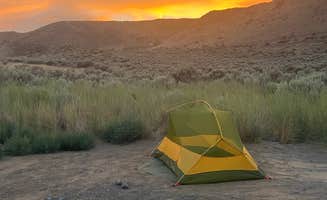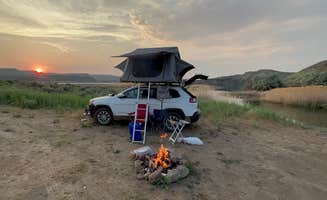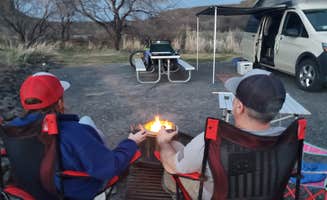Camping options near Hartline, Washington range from established state parks with full amenities to primitive dispersed sites across the Columbia Basin. The area sits at approximately 1,900 feet elevation with summer temperatures frequently exceeding 90°F from June through August. Water levels in Banks Lake fluctuate considerably between seasons, affecting shoreline camping locations and boat launch access.
What to do
Hiking at Steamboat Rock State Park: The dramatic rock formation rises 800 feet above Banks Lake, offering moderate to challenging trails. "We enjoyed this place alot. We walked over to a nice sandy beach and kids walked aways into water before it got deep. We really enjoyed this place... We hiked part of the ways up but didnt go all the way," notes a visitor to Bay Loop Campground.
Fishing opportunities: Banks Lake provides excellent fishing conditions for walleye, bass, and trout. "Fishing was fair for walleye, bass. Hiking was abundant. Easy in and out," reports a camper from Bay Loop Campground. The fishing season typically extends from April through October, with early mornings and evenings being most productive.
Water activities beyond swimming: Rentals available at multiple locations. "There is a boat ramp and and rental boats and small store. If you get a beach front campsite you can beach your boat at your site," explains a visitor to Blue Lake Resort. Several campgrounds offer kayak, paddleboard, and motorboat rentals ranging from $25-50 per day.
What campers like
Beach access for swimming: Sandy beaches provide safer water entry for families with small children. "The swimming area is a short walk away. There's also a second swimming area and a playground within the park that is a quick drive," reports a visitor to Sun Lakes-Dry Falls State Park.
Wildlife viewing opportunities: Expect to see deer, wild turkeys, and waterfowl. "We enjoyed the deer, pheasant and wild turkeys wandering the grounds," mentions a visitor to Bay Loop Campground. Morning and evening hours provide the best wildlife viewing conditions.
Lake views from most campsites: Many established campgrounds place tents and RVs near water. "Really pretty site! There's beach access with clear water and it's all nestled between canyons. Very quiet but doesn't feel isolated," explains a camper at Spring Canyon Campground. Water visibility often exceeds 10 feet in clearer lakes like Roosevelt.
What you should know
Intense wind conditions: Sudden strong winds can damage camping equipment, particularly at night. "It got very windy at night even though it was completely calm when we went to bed. Just a warning to be sure to stake your tent out if you are tenting it like we were. Our tent tried to make a break for it when we were unpacking in the morning," cautions a visitor to Ankeny #1.
Mosquito problems near lakes: Insect activity increases dramatically at dusk. "Lots of bugs. Saw a few people fishing from small boats. There are no trees for shade. But there are lots of very friendly bugs that want to say hi," warns a Trail Lake camper. Bug activity peaks from June through August and intensifies near sunset.
Variable campsite quality: Site privacy and amenities differ significantly across campgrounds. "I was there for a trail run race that went deep in the Sun Lakes back country and the floor of the Dry Falls area. Just stunning scenery. The camping itself is the standard state park experience, sites close together, not much for privacy. But they are nice spots, and well maintained," reports a Sun Lakes-Dry Falls State Park visitor.
Tips for camping with families
Cabins for extreme heat protection: Air conditioning provides crucial relief during hot summer days. "We went here during the summertime and the cabins were just awesome they have a little AC unit in there which made it great to relax and after we had gotten home from hiking around in the rocks," explains a visitor to Cove Loop Campground. Cabin rates typically range from $75-95 per night.
Water safety precautions: Lake depths can change abruptly. "We walked over to a nice sandy beach and kids walked aways into water before it got deep," notes a Bay Loop Campground visitor. Designated swimming areas provide the safest conditions for children.
Playground locations: Several campgrounds offer dedicated play areas. "It was nice and quiet during our stay. The views were beautiful especially of the Grand Coulee Dam," mentions a Spring Canyon Campground visitor. Most playgrounds lack shade protection during midday hours.
Tips from RVers
Hookup variations by loop: Different campground sections offer varying levels of services. "We stayed in the Bay Loop. The sites were all very generous in size and spaced a decent distance apart. The drives are paved and can accommodate large RVs," reports a visitor to Sage Loop Campground. Most full-hookup sites require advance reservations during peak season.
Water pressure concerns: Some campgrounds struggle with consistent pressure during busy periods. "The water coming out of the spigots is hot so I assume the pipes weren't buried deep enough," notes a Blue Lake Resort camper. RVers should consider bringing a pressure regulator and water filter.
Dump station availability: Not all campgrounds provide on-site dumping facilities. "There are no hookups at this location. First time boon docking, so we were not sure what to expect," explains a Spring Canyon Campground visitor. Most campgrounds with dump stations charge a $5-10 fee for non-campers.













